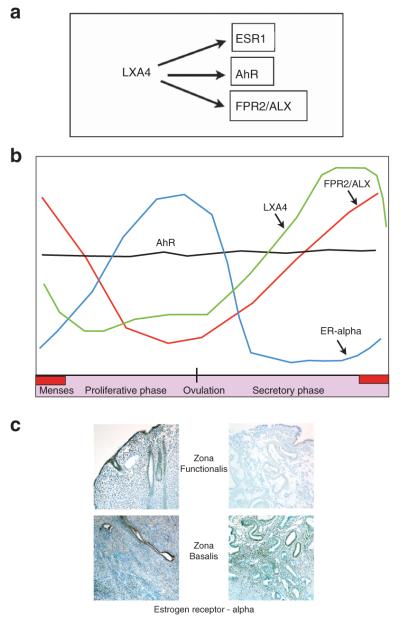Figure 2.
Serum LXA4 levels and receptor expression dynamics in endometrial tissue. (a) Lipoxin A4 (LXA4) activates multiple receptors and has been shown to bind three present in the endometrium; formyl peptide receptor 2/lipoxin A4 receptor (FPR2/ALX), a G-protein-coupled receptor, aryl hydrocarbon receptor (AhR), a nuclear receptor, and estrogen receptor-alpha (ESR1), which can exist in nuclear and membranous forms. (b) Each receptor appears to be differentially regulated, with FPR2/ALX expressed with similar temporal dynamics to LXA4. Serum LXA4 levels have been reported (depicted by a green line), but no data describing endometrial tissue levels have been published. LXA4 also binds to estrogen receptor-alpha (ESR1), which increases in the proliferative phase in response to estrogen and later falls due to progesterone. AhR is constitutively expressed throughout the menstrual cycle, but its functional significance is unclear. (c) Immunohistochemical analyses of ESR1 expression during the secretory phase of the menstrual cycle in both the zona functionalis (left upper panel) as well as the zona basalis (left lower panel). ESR1 is downregulated in the functionalis layer (right upper panel) but maintained in the zona basalis (right lower panel). At menses, when estradiol levels are at their nadir, LXA4 could target the nascent endometrial epithelium and stroma through ESR1 to promote early proliferation and repair. Studies on both humans and primates have provided evidence for cell division in this layer, despite the low endogenous estrogen levels. Thus, LXA4 may serve as an early signal for endometrial regeneration and renewal.

